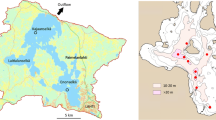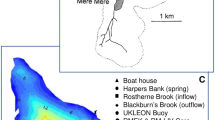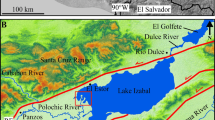Abstract
Lake Kraenepoel (Belgium) is a shallow lake (22 ha), divided in two basins since 1957 by a shallow dike. The lake was used for fish farming until World War II and was drawn down about every 5 years to harvest fish. Despite its dense historical carp population, it had clear water and a rich Littorelletea vegetation. During the course of the 20th century, the lake became eutrophic and the Littorelletea vegetation degraded. The northern basin, which was still drawn down about every decade after 1957, retained its clear water and had a dense submerged macrophyte vegetation. The southern basin, which was never drawn down after 1957 and which received direct surface water inputs, had become a turbid shallow lake with phytoplankton blooms in summer. In 2000, efforts were taken to restore the lake: the entire lake was drawn down, the fish community was biomanipulated, nutrient-rich surface water inputs were diverted from the southern basin and sediments were removed (only in the northern basin). Fish biomanipulation and sediment removal were successful in the northern basin, as nutrient levels declined and the Littorelletea vegetation recovered. In the southern basin, sediment analyses indicated that drawdown resulted in sediments with a lower water and organic matter content and water column turbidity decreased after the drawdown. But pH in the southern basin declined to <4, probably because sulphides in the sediment were oxidized during drawdown and sediment desiccation. In contrast, desiccated sediments were removed from the northern basin and pH did not decline below 6 after restoration. In spite of the still high dissolved nutrient concentrations, phytoplankton biomass declined significantly in the southern basin, probably due to acidification. However, no Littorelletea species colonised the lake bottom in the southern basin. Thus, lake drawdown may be a useful management technique to promote clear water conditions in shallow lakes. However, acidification due to sulphide oxidation may be an undesirable outcome and should be considered in drawdown and sediment desiccation manipulations.





Similar content being viewed by others
References
Blindow, I., A. Hargeby, B. M. A. Wagner & G. Andersson, 2000. How important is the crustacean zooplankton for maintenance of water clarity in shallow lakes with abundant submerged vegetation? Freshwater Biology 44: 185–197.
Bottrell, H., A. Duncan, Z. M. Gliwicz, E. Grygierek, A. Herzig, A. Hillbricht-Ilkowska, H. Kurasawa, P. Larson & T. Weglenska, 1976. A review of some problems in zooplankton production studies. Norwegian Journal of Zoology 24: 419–456.
Brouwer, E., R. Bobbink & J. G. M. Roelofs, 2002. Restoration of aquatic macrophyte vegetation in acidified and eutrofied softwater lakes: an overview. Aquatic Botany 73: 405–431.
Declerck, S., J. Vandekerkhove, L. Johansson, K. Muylaert, J. M. Conde-Porcuna, K. Van der Gucht, C. Pérez-Martínez, T. Lauridsen, K. Schwenk, G. Zwart, W. Rommens, J. López-Ramos, E. Jeppesen, W. Vyverman, L. Brendonck & L. De Meester, 2005. Multi-group biodiversity in shallow lakes along gradients of phosphorus and water plant cover. Ecology 86: 1905–1915.
De Groot, C. J. & C. Van Wijck, 1993. The impact of desiccation of a fresh-water marsh (Garcines Nord, Camargue, France) on sediment water vegetation interactions. 1. The sediment chemistry. Hydrobiologia 252: 83–94.
Dumont, H. T., I. van de Velde & S. Dumont, 1975. The dry weight estimate of biomass in a selection of Cladocera, Copepoda and Rotifera from the plankton, periphyton, and benthos of continental waters. Oecologia 19: 225–246.
Grasshoff, K., 1976. Determination of nitrate and nitrite. In Grasshoff, K. (ed.), Methods of Seawater Analysis. Verlag Chemie, Weinheim, New York, 317 pp.
Gulati, R. D. & E. Van Donk, 2002. Lakes in the Netherlands, their origin, eutrophication and restoration: state-of-the-art review. Hydrobiologia 478: 73–106.
Haney, J. & D. Hall, 1973. Sugar-coated Daphnia: A preservation technique for Cladocera. Limnology and Oceanography 18: 331–333.
Holmer, M. & P. Storkholm, 2001. Sulphate reduction and sulphur cycling in lake sediments: a review. Freshwater Biology 46: 431–451.
James, W. F., J. W. Barko, H. L. Eakin & D. R. Helsel, 2001. Changes in sediment characteristics following drawdown of Big Muskego Lake, Wisconsin. Archiv für Hydrobiologie 151: 459–474.
James, W. F., J. W. Barko & H. L. Eakin, 2004. Impacts of sediment dewatering and rehydration on sediment nitrogen concentration and macrophyte growth. Canadian Journal of Fisheries and Aquatic Sciences 61: 538–546.
Jeppesen, E., M. Søndergaard, E. Kanstrup, B. Petersen, R. B. Eriksen, M. Hammerhøjj, M. Mortensen, J. P. Jensen & A. Have, 1994. Does the impact of nutrients on the biological structure and function of freshwater and brackish lakes differ? Hydrobiologia 275/276: 15–30.
Jeppesen, E., M. Søndergaard, J. P. Jensen, K. E. Havens, O. Anneville, L. Carvalho, M. F. Coveney, R. Deneke, M. T. Dokulil, B. Foy, D. Gerdeaux, S. E. Hampton, S. Hilt, K. Kangur, J. Köhler, E. H. H. R. Lammens, T. L. Lauridsen, M. Manca, M. R. Miracle, B. Moss, P. Nõges, G. Persson, G. Phillips, R. Portielje, S. Romo, C. L. Schelske, D. Straile, I. Tatrai, E. Willén & M. Winder, 2005. Lake responses to reduced nutrient loading – an analysis of contemporary long-term data from 35 case studies. Freshwater Biology 50: 1747–1771.
Hoozee, J., 1978. Ekologisch-systematische studie van het “Kraenepoel”-fytoplankton (O.-Vl.). Unpublished masters thesis, Ghent University, Gent, 160 pp.
Kopacek, J., K. U. Ulrich, J. Hejzlar, J. Borovec & E. Stuchlik, 2001. Natural inactivation of phosphorus by aluminium in atmospherically acidified water bodies. Water Research 35: 3783–3790.
Koroleff, F., 1976. Determination of ammonia, phosphorus and silicon. In Grashoff, K. (ed.), Methods of Seawater Analysis. Verlag Chemie, Weinheim, New York, 317 pp.
Maessen, M., J. G. M. Roelofs, M. J. S. Bellemakers & G. M. Verheggen, 1992. The effects of aluminium, aluminium/calcium ratios and pH on aquatic plants from poorly buffered environments. Aquatic Botany 43: 115–127.
Menden-Deuer, S. & E. J. Lessard, 2000. Carbon to volume relationships for dinoflagellates, diatoms, and other protist plankton. Limnology and Oceanography 45: 569–579.
Murphy, K. J., 2002. Plant communities and plant diversity in softwater lakes of northern Europe. Aquatic Botany 73: 287–324.
Pontin, R. M., 1978. A Key to British Freshwater Planktonic Rotifera. Freshwater Biological Association. Scientific Publication 38, 178 pp.
Qiu, S. & A. J. McComb, 1996. Drying-induced stimulation of ammonium release and nitrification in reflooded lake sediment. Marine and freshwater research 47: 531–536.
Rahel, F. J. & J. J. Magnuson, 1983. Low pH and the absence of fish species in naturally acidic Wisconsin lakes – interferences for cultural acidification. Canadian Journal of Fisheries and Aquatic Sciences 40: 3–9.
Reynolds, C. S., 1984. Freshwater Phytoplankton. Cambridge University Press, Cambridge, 384 pp.
Roelofs, J. G. M., 1983. Impact of acidification and eutrophication on macrophyte communities in soft waters in the Netherlands. I. Field Observations. Aquatic Botany 17: 139–155.
Roelofs, J. G. M., 1996. Restoration of eutrophied shallow softwater lakes based upon carbon and phosphorus limitation. Netherlands Journal of Aquatic Ecology 30: 197–202.
Rudd, J. W. M., C. A. Kelly, D. W. Schindler & M. A. Turner, 1988. Disruption of the nitrogen cycle in acidified lakes. Science 240: 1515–1517.
Ruttner-Kolisko, A, 1974. Plankton rotifers biology and taxonomy. Binnengewasser supplement 36: 1–146.
Scheffer, M., S. H. Hosper, M.-L. Meijer, B. Moss & J. Jeppesen, 1993. Alternative equilibria in shallow lakes. Trends in Ecology and Evolution 8: 275–278.
Scheffer, M., 1998. Ecology of shallow lakes. Population and Community Biology Series 22. Chapman and Hall, London, 357 pp.
Scheffer, M, R. Portielje & L. Zambrano, 2003. Fish facilitate wave resuspension of sediment. Limnology & Oceanography 48: 1920–1926.
Sherr, E. B. & B. F. Sherr, 1993. Preservation and storage of samples for enumeration of heterotrophic protists. In Kemp, P. F., B. F. Sherr, E. B. Sherr & J. J. Cole (eds), Handbook of Methods in Aquatic Microbial Ecology. CRC Press, Boca Raton, 207–212.
Ulrich, K. U. & R. Pöthig, 2000. Precipitation of aluminium and phosphate affected by acidification. Acta Hydrochimica et Hydrobiologica 28: 313–322.
Vadeboncoeur, Y., E. Jeppesen, M. J. Van der Zanden, H.-H. Schierup, K. Christoffersen & D. M. Lodge, 2003. From Greenland to green lakes: cultural eutrophication and the loss of benthic energy pathways in lakes. Limnology & Oceanography 48: 1408–1418.
van Dam, H. & R. F. M. Buskens, 1993. Ecology and management of moorland pools – balancing acidification and eutrophication. Hydrobiologia 265: 225–263.
Van den Berg, M. S. W. Joosse & H. Coops, 2003. A statistical model predicting the occurrence and dynamics of submerged macrophytes in shallow lakes in the Netherlands. Hydrobiologia 506: 611–623.
Van der Meersch, E., 1874. Notice sur la florule du Kraene-Poel. Bulletin de la société Royale de botanique de Belgique 13: 224–241.
Van Geest, G. J., H. Coops, R. M. M. Roijackers, A. D. Buijse & M. Scheffer, 2005. Succession of aquatic vegetation driven by reduced water-level fluctuations in floodplain lakes. Journal of Applied Ecology 42: 251–260.
Van Haesebroeck, V., D. Boeye, B. Verhagen & R. F. Verheyen, 1997. Experimental investigation of drought-induced acidification in a rich fen soil. Biogeochemistry 37: 15–32.
Van Oye, P., 1941. Etude biologique des Desmidiées de l’étang du Kraenepoel (Belgique). Biologisch Jaarboek Dodonaea 8: 173–293.
Acknowledgements
The research presented in this paper was carried out in the framework of a LIFE-project (LIFE98NAT/B/5172): ‘Restoration and management of Lake Kraenepoel (Aalter)’ financially supported by the EC and the Flemish (AMINAL/NATUUR) and local (Aalter) governments. Special thanks to the Pettiaux family, owners of the northern section of the lake, for their agreement to study and restore their property, Koen Himpe (Belconsulting NV) for supervising the restoration efforts, Nele Nuyten for the help during sampling and zooplankton analysis, Sara Denayer for the counting of several phytoplankton samples, Dirk Libbrecht (Geolab BVBA) and Wim Kerstens (Belconsulting NV) for gathering and analyzing data concerning sediment characteristics, Pieter Vanormelingen for some statistical questions and identifications of desmids, Dirk Van Gansbeke for the analysis of dissolved nutrients and the head (Viviane Vandenbil, AMINAL) and members of the supervising committee for their stimulating discussions. SD is a post-doctoral fellow with the Fund for Scientific Research, Flanders (FWO-Vlaanderen).
Author information
Authors and Affiliations
Corresponding author
Rights and permissions
About this article
Cite this article
Van Wichelen, J., Declerck, S., Muylaert, K. et al. The importance of drawdown and sediment removal for the restoration of the eutrophied shallow Lake Kraenepoel (Belgium). Hydrobiologia 584, 291–303 (2007). https://doi.org/10.1007/s10750-007-0611-z
Issue Date:
DOI: https://doi.org/10.1007/s10750-007-0611-z




